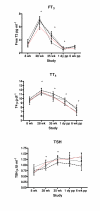Prevalence of pre- and postpartum depression in Jamaican women
- PMID: 16277665
- PMCID: PMC1310611
- DOI: 10.1186/1471-2393-5-15
Prevalence of pre- and postpartum depression in Jamaican women
Abstract
Background: Maternal depression during pregnancy has been studied less than depression in postpartum period. The aims of this study were to find out the prevalence of prepartum and postpartum depression and the risk factors associated in a cohort of Afro-Jamaican pregnant women in Jamaica.
Methods: The Zung self-rating depression scale instrument was administered to 73 healthy pregnant women at 28 weeks gestation and at 6 weeks postpartum for quantitative measurement of depression. Blood samples were collected at 8, 28, 35 weeks gestation and at day 1 and 6 weeks postpartum to study the thyroid status.
Results: Study demonstrated depression prevalence rates of 56% and 34% during prepartum and postpartum period, respectively. 94% women suffering depression in both periods were single. There were significant variations in both FT3 and TT4 concentrations which increased from week 8 to week 28 prepartum (p < 0.05) and then declined at the 35th week (p < 0.05 compared with week 28) and 1 day post delivery study (p < 0.05 compared with week 35). The mean values for TSH increased significantly from week 8 through week 35. The mean values at 1 day postpartum and 6 week postpartum were not significantly different from the 35 week values. For FT3, TT4 and TSH there were no significant between group differences in concentrations. The major determinants of postpartum depression were moderate and severe prepartum depression and change in TT4 hormone concentrations.
Conclusion: High prevalence of depression was found during pre- and postpartum periods. Single mothers, prepartum depression and changes in TT4 were factors found to be significantly associated with postpartum depression.
Figures
References
-
- Kitamura T, Sugawara M, Sugawara K, Toda MA, Shima S. Psychosocial study of depression in early pregnancy. Br J Psychiatry. 1996;168:732–738. - PubMed
-
- Johanson R, Chapman G, Murray D, Johnson I, Cox J. The North Staffordshire Maternity Hospital prospective study of pregnancy associated depression. J Psychosom Obstet Gynaecol. 2000;21:93–97. - PubMed
LinkOut - more resources
Full Text Sources



